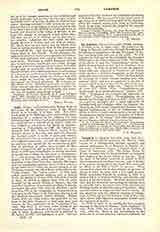

Lamarck (LA MARCK; bot. abbr. Lam., zool. Lm.), JEAN-BAPTISTE-PIERRE-ANTOINE DE MONET, CHEVALIER DE, a distinguished botanist, zoologist, and natural philosopher, b. at Bazentin in Picardy (department of Somme), France, August 1, 1744; d. at Paris, December 18, 1829. His father, Pierre de Monet, intended him for the priesthood. so Lamarck first studied at the Jesuit college at Amiens. Upon the death of his father, however, he joined, in 1671, the French army in northern Germany, and on the day of his arrival, during the Seven Years’ War, was made an officer on the field of battle for bravery. When twenty-four years old he was obliged, on account of illness, to leave the army with a very small pension. While supporting himself by working as clerk in a bank at Paris, he studied medicine, meteorology, and botany in his spare hours. He never practiced medicine, and his numerous meteorological writings have no scientific value; the same is true of his physical and chemical works, in which he opposed Lavoisier. They were all written to support himself and his family. It was otherwise with the different branches of biology: from 1778 he was an able botanist, from 1794 a zoologist, about 1800 began his speculative labors upon the variation of species.
In 1778 he wrote in six months the first complete account of the flora of France, “Fiore francaise” (3 vols., Paris, 1778; 3rd ed. edited by de Candolle, 6 vols., 1805-15). Both in the introduction to this work and in several treatises, Lamarck explained the analytical, dichotomous system of determining the species of plants, a system originated by him and now much used. In classification he maintained the principle, in opposition to Jussieu, that a single part, no matter how essential, was not sufficient for the classification of the plant but that, in classification, all parts should be considered. This work led to his acquaintance with Buffon and in 1779 gained his election to the Academy of Sciences. With Buffon’s son he then traveled through Holland, Germany, and Hungary. Once more in Paris he became a contributor to the “Encyclopedie methodique”, for which he wrote the first four volumes of the “Dictionnaire de botanique” (Paris, 1783-96). In this work the genera of plants are skillfully treated in alphabetical order from A to P, the great collections of Paris being exhaustively drawn upon. The large atlas “Illustration des Genres”, which accompanied the work, contains 900 plates. Lamarck began a “Histoire naturelle des vegetaux” (Paris, 1802), as part of the compilation “Suites de Buffon”; Mirbel continued the “Histoire naturelle” from volume III to XV. In the mean-time Lamarck had received, in 1789, the position of keeper of the herbarium at the Jardin des Plantes as assistant to Daubenton, but he soon lost it. At no time in his life was he in very prosperous circumstances. When the Museum d’Histoire Naturelle was reorganized in 1793 there were no professors of zoology. The professorship for the lower animals was offered to the botanist Lamarck, and he had the courage at the age of forty-nine to teach himself zoology. He commenced his zoological lectures in 1794 and carried them on until blindness forced him in 1818 to transfer them to the entomologist Latreille.
Lamarck began by separating the animal kingdom into the two important divisions of vertebrates and invertebrates. He sought to develop the classification of invertebrates (“Systeme des animaux sans vertebres”, Paris, 1801), and established numerous new genera and species for them. His most important zoological work is the “Histoire des animaux sans vertebres” (7 vols., Paris, 1815-22; 2nd ed., 11 vols., 1835-45). Particular mention should be made of Lamarck’s investigations concerning mollusks, especially his studies of the geologically important fossil mollusks. For the last twenty years his reputation has been far greater than in his lifetime in a steadily increasing degree. His theoretical views concerning life-forms which were often regarded by his contemporaries, as by Cuvier, only as droll, fantastic crotchets, unworthy of notice or even of contradiction, are now considered by many biologists as showing in the highest degree the originality of genius. These views are expressed in numerous treatises issued during the e period 1802-20 but especially in his work “Philosophie zoologique” (2 vols., Paris, 1809, 1839, 1873, etc.; lately translated into other languages). They are the basis of that form of evolution which as Lamarckism, and of late in sharp opposition to Darwin as neo-Lamarckism, has distinguished adherents among botanists, zoologists, and palaeontologists. These adherents, however, do not agree among themselves. Every year in increasing number appear popular and scientific works upon Lamarck and Lamarckism. His ideas were partly influenced by Maillet, Condillac, Rousseau, and especially by Buffon. Lamarck can with more right than Darwin be called the originator of the theory of evolution, just as he was also the first to choose the form of a genealogical tree to illustrate the genetic connection of organisms. According to him only a few species have died out; for the most part they have been modified. However, the word Lamarckism means above all the impelling forces, postulated by Lamarck, of phylogeny: the use or disuse of the organs, occasioned by need, consequently by a factor inherent in the life-form, is said to call forth adaptations which become permanent by heredity. Lamarck was, therefore, a vitalist, not a materialist; he was also neither an atheist, nor irreligious, nor an opponent of the Scriptures. On the contrary, in regard to the creation of man he frankly placed the authority of the Bible higher than his own ideas. At least there is no valid reason for regarding his words relative to this as hypocritical, as many Lamarckians do. Lamarck’s name is perpetuated in botany in the genera Monetia, Markea, Lamarchdea, and Lamarckia. In 1909 a monument to him was unveiled in the Museum d’Histoire Naturelle at Paris.
JOSEPH ROMPEL

